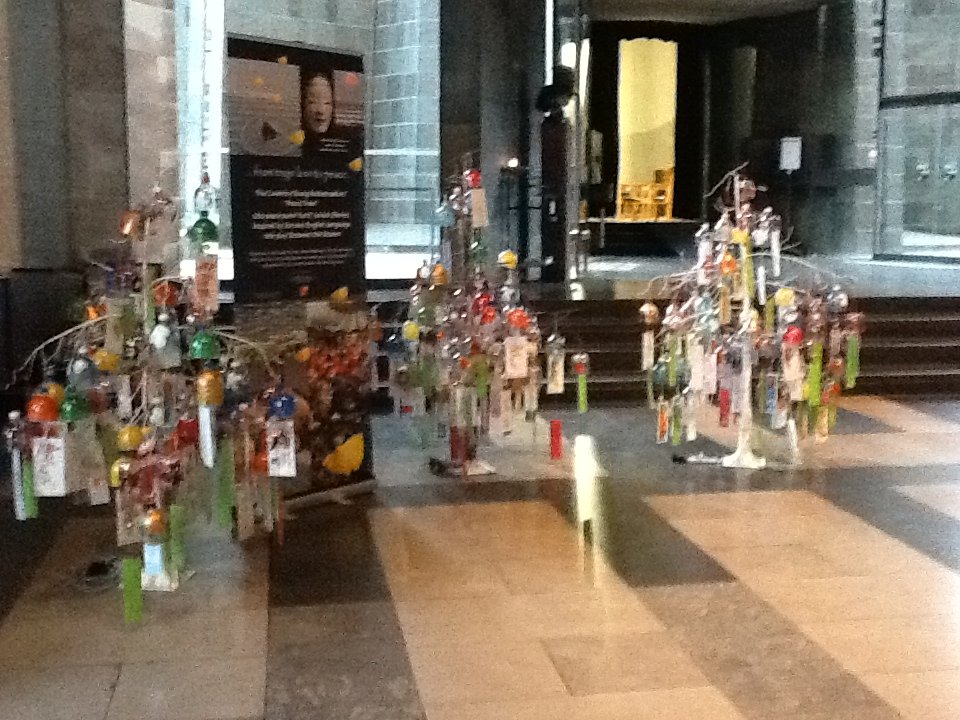e-Forest for Peace Project
The Arts & Culture for Peace Initiative encourages action that supports the three UNESCO ASPnet Action Areas and at the same time will benefit individual children and our wider communities.
This page outlines the ASPnet Arts & Culture for Peace Initiative ‘e-Forest for Peace’ activity objectives. It provides some background information and useful links to materials to support schools as they begin this Initiative.
Coventry Young Ambassadors ‘Peace Trees’
On display at Coventry Cathedral were locally relevant as well as being part of the centenary of Armistice Day on 11 November 2018 - and the end of WW1.
Objectives
Using their Conflict and Peace Study, schools will contribute to the creation of an international virtual forest of peace trees (real or imagined), laden with tanzaku poems and images focused on the importance of living in peace with ourselves, our communities, and our planet. The ‘less is more’ minimalist approach will influence the students’ work both creatively and intellectually.
Students will be able to write, draw, or research individual peace poems and images which will be displayed from peace trees (real or imagined). If these are hung/displayed from wind chimes they should be made from recycled or found materials, thus demonstrating how much more value can be gained from using ‘less’ materials.
Using the same approach students will be able to design or use sustainable ‘peace trees’ of their choice (real or imagined) on which their peace poems can be displayed. Whether they use real trees, for example, by joining and adding value to a local tree-planting project; or create ‘tree’ concepts created from found objects or other structures, is entirely up to the students.
Participants will also determine where their peace trees might be displayed locally, so that they can be appreciated by local communities.
The peace trees will contribute to a ‘virtual’ international ‘ASPnet e-Forest of Peace’ bringing the creative efforts of schools towards realising support and benefit to the ASPnet Action Areas together.
Teachers’ Notes
Participants should read the generic introduction about the Initiative, the Guidance notes and also the recording and sharing of activities.
Timescale
Schools can register at any time.
The time needed to work on this activity could be as little as one class session, or it could be undertaken over a period, depending on the length of time teachers wish to give to the research element and how this may be connected to their curriculum and/or to the other parts of the whole initiative, or indeed a local community initiative.
Initially we are keen to focus on developing projects that will deliver a major impact beginning in 2025 - greater value and impact will be gained by as many countries contributing project outcomes together to emphasis the need for urgent action
Longer term benefits will be gained by projects focused on creating a legacy for local communities that will have an ongoing impact for future generations.
Resources
The creation of the ‘Peace Trees’ should be achieved using either existing local resources, or recycling resources to reflect the spirit of sustainability. Students and teachers should aim to be imaginative in their use of recycled and found materials, and the way they conceive the trees to reflect the ASPnet Action Areas, including joining a related tree-planting project if it exists locally.
Sharing of ‘Peace Trees’ internationally should be as follows:
the narrative description of the project should be between 400-600 words
a maximum number of artistically good quality photos 10
if you have made a video which its central to your project upload it to a local site (school or community project, for example) and send a link only to the national coordinators to share on the Arts & Culture for Peace site.
Quality
Students are aiming to achieve artistically diverse and beautiful outcomes in completing, or incorporating this part of the initiative. Working together schools would like to achieve the most interesting, beautiful and unique global ‘e-forest for peace’. Students should aim to communicate the essence of the ASPnet Action Areas of peace, sustainability and intercultural learning.
This is potentially the simplest of the three activities and we would like to encourage as many as possible to undertake this activity - in order to achieve as wide a global impact as possible together.
Useful links
Short video of the Coventry experience from the Coventry local coordinator’s perspective (still to come).
The history of haiku, tanzaku (poem cards) and furin (wind chimes). How to write haiku, and make a tanzaku and furin from recycled materials (Japan Society Education Resources)
(NB: The Japan Society have prepared these materials for English-speaking students who are interested in these Japanese forms.)
Kew Gardens, London. 2021 Japanese exhibition example of Haiku, One Thousand Springs by Japanese artist, Chiharu Shiota
What is minimalism?
People links
If you want to ask questions related to this activity you can contact the UK UNESCO National Coordinator
For classical Japanese references in English: If you want to ask specific questions about the history of haiku or making of tanzaku and furin you can contact the Education Team at the Japan Society.

